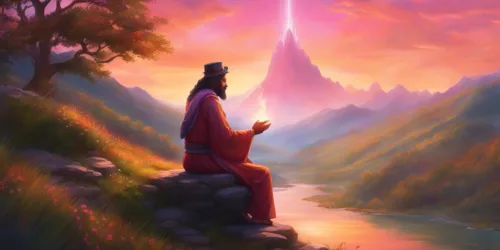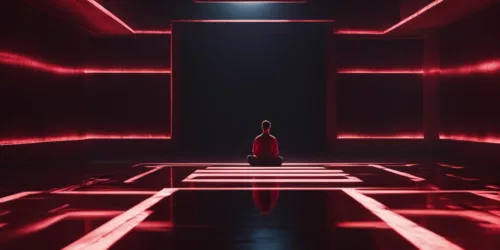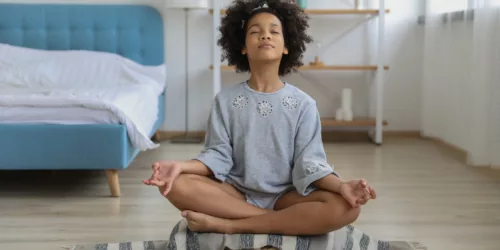The Parable of the Second Arrow: When Suffering is Optional

Life might be chucking metaphorical arrows at you left, right, and center, but how you react to them, especially that pesky second arrow, has profound implications. Dive into the teachings of Buddha, understand the stark difference between pain and suffering, and discover the mindfulness techniques that might just make life a little more bearable (and with fewer arrows).
1. What’s the Story with the Two Arrows?
Imagine walking in the woods, minding your own business, when suddenly — whoosh — an arrow hits your arm. It’s painful, no doubt about it. That’s your first arrow. But before you even have time to wince, another thought sneaks into your brain. What if you can’t get the arrow out? Or if you can’t find help? What if you’re doomed to wander the woods, an arrow jutting out like some strange organic compass? That’s your second arrow — and, spoiler alert, it’s often self-inflicted. The story of the two arrows isn’t just about walking in forests and dodging pointy things; it’s a tale of human experience and the additional suffering we heap onto ourselves.
“In life, we cannot always control the first arrow. However, the second arrow is our reaction to the first. And with this second arrow comes the possibility of choice.”
2. Why did Buddha Talk About Arrows?
The parable of the second arrow is a Buddhist teaching, one that the Buddha himself shared. Now, you might be wondering, “Did Buddha run into a lot of archers or something?”, but stay with me here.
Buddha often used metaphors to explain complex ideas, and in this case, he used the analogy of being struck by an arrow to explain the concept of pain and suffering. Sure, the Buddha didn’t enjoy being sick or getting hurt (who does?), but he didn’t beat himself up mentally about it either. He understood that the physical pain of the first arrow was inevitable, but the mental torture of the second arrow was a choice.
3. First Arrow vs. Second Arrow: What’s the Real Deal?
Imagine you’re having one of those Mondays. You’ve spilled coffee on your white shirt, you’ve gotten a parking ticket, and now you’re late for a meeting. That’s your first arrow. We’ve all been there. But here comes the curveball. You start thinking:
- Why am I so clumsy?
- Why is life so unfair?
- Does coffee have a personal vendetta against me?
Those self-deprecating thoughts, ladies and gents, are your second arrows. They’re the things we tell ourselves, the narrative we build that isn’t just about the event but about our interpretation of the event.
Remember, the first arrow is external and often out of our control. It’s the stuff that life throws at us. The second arrow, on the other hand, is entirely internal. It’s our reaction, our mindset, and sometimes our overactive imagination (like thinking your coffee is out to get you).
4. Pain is Certain, but is Suffering Really Optional?
As the saying goes, “Pain is inevitable, but suffering is optional.” It’s a compelling quote, but let’s face it, easier said than done. It’s easy to fall into the trap of the second arrow after the sting of the first. After all, we’re only human. So, let’s dissect this a bit.
The first arrow, whether it’s a physical pain or emotional setback, is often beyond our control. It’s the natural flow of life. However, the second arrow, our response to the pain, is within our control. We often amplify our pain by overthinking, obsessing, and creating narratives that might not even exist.
“It’s not the actual event, but our interpretation of it, that causes suffering.”
The challenge? Recognising when that second arrow is being drawn and learning to dodge it or at least not shoot it ourselves.
5. What Role Does Mindfulness Play in Dodging that Second Arrow?
Mindfulness is often seen as a buzzword, but there’s a reason it’s stood the test of time, especially in Buddhist teachings. Mindfulness is about being present, being aware, and not letting the ‘what ifs’ and ‘should haves’ hijack your brain.
By practicing mindfulness, you develop the ability to observe your reactions without immediately acting on them. It’s like watching a movie of your thoughts without being an actor in it. This distance can give you a fresh perspective and allow you to decide if you want to react or let the moment pass. It’s about pausing before reaching for that second arrow.
6. How to Recognise and Refrain from the Second Arrow in Daily Life

Real-world application time! Let’s take a scenario many can relate to: dirty dishes left in the sink by a roommate or partner. The act itself – the dirty dishes – is your first arrow. Annoying? Yes. Life-ending? No.
But what often happens next? Our thoughts spiral. “They’re always leaving a mess for me to clean up,” or “They clearly don’t care about shared responsibilities.” Those thoughts? Yep, that’s the second arrow.
Tips to dodge the second arrow in everyday situations:
- Self-awareness: Recognise your triggers. If dirty dishes always lead to a mental tirade, that’s a sign.
- Reframe the narrative: Instead of thinking, “They always leave a mess,” try, “Maybe they had a rough day.”
- Practice deep breathing: It’s amazing what a few deep breaths can do to clear the mind.
- Communicate: Instead of internalizing, talk it out. Maybe they weren’t even aware of their arrow-shooting prowess!
7. The Power of Self-compassion in Dealing with the Second Arrow
We’re often our harshest critics. When things go wrong, our internal dialogue can be more damaging than any external words. Self-compassion is about treating yourself as you would a friend. Would you berate a friend for spilling coffee or being late? Probably not.
By practising self-compassion, you halt the second arrow in its tracks. It’s about understanding that mistakes happen, not every day will be perfect, and that’s okay. The next time you’re tempted to go on an internal rant, pause and ask yourself: “What would I tell a friend in this situation?”
8. How Our Interpretation of Events Plays a Role in Our Suffering
Our brains are hardwired to find patterns and make sense of situations. But sometimes, this tendency can be our downfall. We’re quick to interpret events, often in the worst possible light. Someone doesn’t reply to a text, and we think they’re mad at us. We’re not invited to a gathering, and we assume everyone dislikes us. These interpretations are often our second arrows.
Being aware of how we interpret events is the first step in breaking the cycle. Understanding that not everything is a reflection of us can lessen the impact of these interpretations.
9. Personal Tales: When the Second Arrow Struck Hard
We’ve all been there: that moment when not just one, but multiple arrows seem to pierce us. I once came down with a cold, the first arrow. What should’ve been a few days of rest turned into a week of misery. Not because the cold was severe, but because my mind went on an overdrive: “What’s going to happen to my family if this gets worse?” or “I didn’t enjoy being sick, but I also didn’t beat myself up mentally about what’s gonna happen next.” That endless spiral? Classic second arrow.
“In life, sometimes we’re the archer, sometimes the target. Knowing the difference can spare us much unnecessary suffering.”
10. Breaking the Cycle of Endless Second Arrows
Knowing about the second arrow is half the battle. But how do you stop the endless cycle once it starts? Here’s a strategy:
- Recognize the trigger: The moment you feel the sting of the first arrow, be on alert for the second.
- Pause and breathe: Give yourself a moment before reacting.
- Challenge your narrative: Ask, “Is this really true, or is it my interpretation?”
- Seek external perspectives: Sometimes, a fresh pair of eyes (or ears) can provide a different viewpoint.
11. The Parable’s Influence in Modern Mindfulness and Therapies
The parable of the two arrows isn’t just a historical anecdote. Its principles are often used in mindfulness practices and even modern therapies. Understanding the difference between unavoidable pain and self-inflicted suffering can be a game-changer in how we process emotions and challenges.
- Mindfulness: Being present, acknowledging the first arrow without immediately launching the second.
- Cognitive Behavioral Therapy (CBT): This therapy often helps individuals recognize and challenge their second arrow thoughts.
- Self-compassion practices: Focusing on kindness towards oneself, lessening the impact of the two arrows.
12. Concluding Thoughts: Mastering the Art of Arrow-Dodging
As the Buddha once suggested, life will present its set of first arrows. Physical pains, emotional upheavals, and unexpected events are a part of the journey. But the second arrows? Those are optional. By recognizing them, understanding their origin, and practicing self-awareness and compassion, we can lead a life with lesser unnecessary suffering.
Key takeaways:
- Recognize the difference between the first and second arrows.
- Use mindfulness and self-awareness to identify and prevent the second arrow.
- Treat yourself with compassion; you’re human after all.
- Understand that while pain might be inevitable, prolonged suffering is a choice.
Remember: “Suffering is optional. So, the next time you find yourself reaching for that second arrow, maybe give it a miss and reach for a cup of tea instead. “
FAQs
What is the Parable of the Second Arrow?
In Buddhist teachings, the Parable of the Second Arrow, or commonly referred to as the story of the two arrows, is a metaphor used to explain the relationship between physical affliction and mental suffering. The parable goes that when a person is struck by an arrow, they experience physical pain – that is the first arrow. However, if they are struck by a second arrow, is imparting unnecessary mental anguish and distress – it’s the second arrow of suffering. The Buddha explains that while the first arrow is often out of our control, the second is entirely within our control.
What does the second arrow represent in Buddhism?
In Buddhism, the second arrow represents one’s reaction to the initial pain or affliction. Often, it is our negative or discouraging thoughts, our self-criticism, and our overwhelming anxiety – essentially, our mental suffering imposed upon the original physical pain. Buddha once asked a student, “when an individual is struck with an arrow, does he feel one arrow’s pain or two?” hence highlighting the idea that unnecessary suffering is self-inflicted.
What’s the idea of pain and suffering separation in the Parable of the Second Arrow?
The Parable of the Second Arrow prominently explores the difference between pain and suffering. The first arrow represents the unavoidable physical pain we may face in life, while the second indicates the psychological or emotional distress that we let accompany that pain. The Buddha emphasized that while pain might be inevitable; suffering is optional.
How can the Parable of the Second Arrow be applied in everyday life?
We often add to our suffering by reacting negatively to pain or stress. This reaction is the second arrow. Whether it’s blaming ourselves for getting sick when we could have prevented it or worrying about consequences that are yet to materialise – that’s the self-inflicted second arrow of suffering. Understanding this concept helps practicing mindfulness by asking ourselves, “What am I telling myself about this situation?” and “How am I contributing to my pain?” This approach helps in dealing with suffering constructively.
There you have it. A deep dive into the realm of arrows, suffering, and the power of choice. Whether you’re a Buddhist monk or a modern-day warrior battling daily challenges, the tale of the two arrows holds lessons for us all. As always, dodge, duck, dip, dive, and… dodge.






